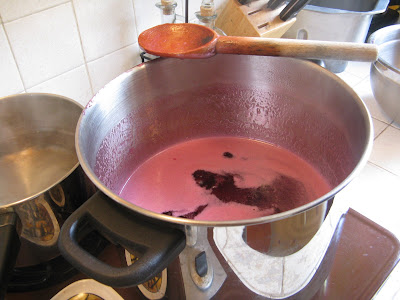Quick crash course in jam / jelly / marmalade basics, or should I say the world of preserves. Jams are the result of combing crushed or chopped fruit with sugar and maybe pectin. Jelly, on the other hand, specifically utilizes fruit juice rather than chopped fruit, along with sugar and pectin, and should be very jiggly. Marmalades are soft jellies with fruit rinds suspended inside, usually citrus (going deeper into preserves, conserves are two fruits mixed with sugar and nuts, chutneys boast fruit, vinegar, sugar and spices, and relishes are a cooked combination of fruit and/or vegetables preserved with vinegar). We're lucky enough to have a healthy vine of concord grapes growing in the backyard, and after two straight years of using the fruit strictly for grape juice, we decided to make a small batch of grape jelly.

One attractive aspect of making jams and jellies is the rapidity with which the fruit sets, allowing the impatient some rather immediate feedback. Within 24 hours of properly preparing most jellies, you can pop the top and have a taste.
We began by purchasing a set of glass jars, smaller than those used for pickling (not wanting to make the long drive back up to Escondido's lovely country store, we cast about San Diego for what we needed. It's not the most canning-friendly city in the country, let's just say. Thanks to Ocean Beach Hardware, we were able to stay close to home).

The grapes were picked from the vine and carefully cleaned. We extracted the juice by filling a large pot with the grapes and a small amount of water, placing over low heat, covering, and allowing to cook for an hour or so. The grapes sweated and mushed their way into oblivion, leaving behind several cups' worth of inky-purple-black liquid gorgeousness. We then measured the concoction into 4-cup servings.
An obscene amount of sugar was called for and added to the still-hot grape juice. So much for counting calories.
The secret ingredient for our jelly was liquid pectin, a "structural heteropolysaccharide contained in the primary cell walls of terrestrial plants," according to scientific sources. It's simply a gelling agent taken from apples, plums or other citrus fruits. Pectin is your jelly friend - it makes the difference between creating sweet fruit juice and sweet quivering fruit jelly.
The pectin was added to the broiling grape juice and unmentionable amounts of sugar....
...and the rich brew was stirred by yours truly for a short amount of time while watching for the telltale signs of thickening and setting of the pectin.

Then began the familiar ritual of slowly filling the sterilized jars with the hot juice-pectin combination. The tops and sides also needed to be carefully cleaned of any drops or spatters of juice.


Into the rack they went. The jars were submerged in the boiling water for a mere 5 minutes.

And that was that. We removed the jars from the boiling water and placed them on the kitchen table to cool.

Jane waited patiently for the jars to seal with their wonderful little thunks. Some sealed faster than others.

We placed the box of jellies (seven jars in all) inside our closet to share space with the stubborn pickles. But a mere twenty-four hours later, we popped one of the jars open to sample. A perfect spoonful of quivering sweet goodness.
Spread onto some homemade sesame bread, the jelly (despite its large sugar qualities) becomes, as the commercials for sugar-bomb cereals used to claim, "part of this healthy balanced breakfast".




















2 comments:
Beautiful breakfast. Can I order one up for tomorrow?
Well documented! Hope there will be some left for mom and dad to taste
Dad
Post a Comment